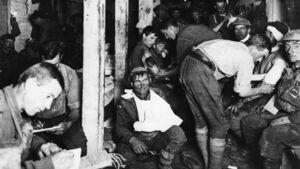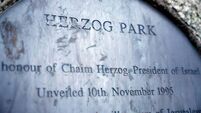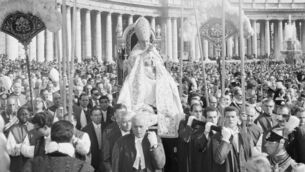Local men who died in the First World War

British Army soldiers relaxing and having wounds treated in an underground forward dressing station by the Menin Road in France during World War I. Picture: Frank Hurley/Three Lions/Getty Images
This is piece number 100 in this series and I am dedicating it to the men of the Ox Mountain region who lost their lives in World War I. It is inspired by the research of Simone Hickey and her recently published book, .
Men joined up and fought in World War I, also known as the Great War, for all kinds of reasons; some fought for the Empire, some fought for Ireland, some fought for the Catholic Church and others fought just to feed their families. Some went willingly, others were shamed into it. Some went in hope, others in fear. But so many went… and so many died. Many of those who died were only at the front line a few short weeks, even days and they died in the most horrific conditions imaginable.
The single spark that started World War I was the assassination of Archduke Franz Ferdinand of Austria in June 1914 by a Bosnian Serb student, Gavrilo Princip. At the time, the continent’s armies were mobilising against each other. The world watched with bated breath as Europe marched towards war. According to information provided by the Imperial War Museum, when the war eventually started, hope of a short campaign was soon dashed.
It was at this point that the British realised that they needed more soldiers to fight the war and so a propaganda and recruitment campaign began throughout the Empire. Every town and village were visited, including those in Sligo and Mayo, and every man and every boy was urged, for one reason or another, to sign up.
The foregoing reference to Belgium is important in an Irish context. Belgium was seen as a Catholic country, with many similarities to Ireland, and the defenceless attack on it by Germany was seen as an attack on Catholic countries everywhere. This perceived threat was levered to the full in getting Irish Catholics to sign up for military service and indeed this recruitment approach was fully endorsed by the Irish Catholic Church at that time.
Taking in an area from Ballisodare to Aclare and from Tubbercurry to Enniscrone, 136 of those men, detailed in Hickey’s research, were either born on the Ox Mountain or in its shadow. Her findings show that, in total, over 600 men from County Sligo died in the war. If the Ox Mountain towns and villages of County Mayo, such as Killasser, Swinford, Straide and Foxford were to be included, this list of Ox Mountain men who died in the war would easily total over 1,000.
is a book that honours the men from Co Mayo who died in many wars, including World War I. It was compiled by Michael Feeney, who chaired the committee that established the Mayo Peace Park, which is based in Castlebar and is a monument to all those featured in the book. Mayo and the First World War by Damian McDonnell is another excellent resource: https://mayoandthefirstworldwar.weebly.com.
Through meticulous research, Hickey’s work provides names, ages, family backgrounds, and local connections. She paints a vivid picture of a community’s sacrifice and the heavy toll of war. These men left for distant battlefields, never to return but her work brings them back to the place they once called home, ensuring that their memory endures and their service is acknowledged.
In Simone Hickey’s own case, the unspoken story of her great-grandfather, Terence Rooney, was the trigger that set her on a journey of discovery. He was one of the 200,000 citizens from the island of Ireland who fought in the Great War. Hickey explains, in the introduction to her book, the great sense of loss and the lack of acknowledgement that surrounded those who lost their lives in this way. She also explains how the story of her great-grandfather was lost for so long.
Another of Hickey’s acknowledgements of the Sligo people who died in World War I was her pulling together an Armistice Walk in Sligo town in November 2018. She recruited over 600 volunteers to participate in the walk, each to represent one of the fallen. People were asked to turn up in period costume and walk the route through Sligo town in silence. Hickey gives the following reflection on that walk.
On that walk, I was honoured to represent one of the three men from Cloonacool who were lost in the war. John Patrick Quinlan was killed in action in October 1918, just a few weeks short of the end of the war. Quinlan's remains were later reburied in Kilcummin Graveyard, beside the Moy, at the foot of the Ox Mountains.





